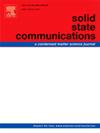Theoretical analysis on vibration reduction characteristics of a novel phononic-like crystal plate structure
IF 2.4
4区 物理与天体物理
Q3 PHYSICS, CONDENSED MATTER
引用次数: 0
Abstract
The ambient vibrations have been paid widespread attention in the engineering field, especially for low-frequency vibrations of plate structures. Local resonance phononic crystals (LRPCs) can obtain low-frequency band gaps, providing new ideas and methods for solving the low-frequency vibration problems of plate structures. Nevertheless, the traditional LRPC plate structures have a narrow bandgap width and a relatively single bandgap, making it difficult to apply in practical engineering. Thus, this paper proposes a phononic-like crystal (PLC) plate model with multiple low-frequency band gaps. This new PLC plate takes into account the elastic constraints of the foundation, external loads, and material damping. The characteristics of band structure and vibration transmission of the new PLC plate structure, and the influences of the coupling effects of the external forces and elastic constraints, and damping ratio of material on characteristics of vibration reduction are analyzed by theoretical calculations in detail. The results show that the PLC plate can open six low-frequency bandgaps within 200 Hz, the vibrations can significantly attenuate within the bandgaps, and the maximum attenuation amplitude can reach 22 dB. The elastic constraints and material damping have significant impacts on vibration attenuation characteristics, while external forces have little effect.
一种新型类声子晶体板结构减振特性的理论分析
环境振动问题在工程领域受到广泛关注,尤其是板结构的低频振动问题。局域共振声子晶体(lrpc)可以获得低频带隙,为解决板结构的低频振动问题提供了新的思路和方法。然而,传统的LRPC板结构带隙宽度窄,带隙相对单一,难以在实际工程中应用。因此,本文提出了一种具有多个低频带隙的类声子晶体(PLC)板模型。这种新的PLC板考虑了基础的弹性约束、外部载荷和材料阻尼。通过理论计算,详细分析了新型PLC板结构的带式结构和振动传递特性,以及外力和弹性约束耦合效应、材料阻尼比对减振特性的影响。结果表明,该PLC板可在200 Hz范围内打开6个低频带隙,振动在带隙内衰减明显,最大衰减幅度可达22 dB。弹性约束和材料阻尼对振动衰减特性有显著影响,而外力影响较小。
本文章由计算机程序翻译,如有差异,请以英文原文为准。
求助全文
约1分钟内获得全文
求助全文
来源期刊

Solid State Communications
物理-物理:凝聚态物理
CiteScore
3.40
自引率
4.80%
发文量
287
审稿时长
51 days
期刊介绍:
Solid State Communications is an international medium for the publication of short communications and original research articles on significant developments in condensed matter science, giving scientists immediate access to important, recently completed work. The journal publishes original experimental and theoretical research on the physical and chemical properties of solids and other condensed systems and also on their preparation. The submission of manuscripts reporting research on the basic physics of materials science and devices, as well as of state-of-the-art microstructures and nanostructures, is encouraged.
A coherent quantitative treatment emphasizing new physics is expected rather than a simple accumulation of experimental data. Consistent with these aims, the short communications should be kept concise and short, usually not longer than six printed pages. The number of figures and tables should also be kept to a minimum. Solid State Communications now also welcomes original research articles without length restrictions.
The Fast-Track section of Solid State Communications is the venue for very rapid publication of short communications on significant developments in condensed matter science. The goal is to offer the broad condensed matter community quick and immediate access to publish recently completed papers in research areas that are rapidly evolving and in which there are developments with great potential impact.
 求助内容:
求助内容: 应助结果提醒方式:
应助结果提醒方式:


